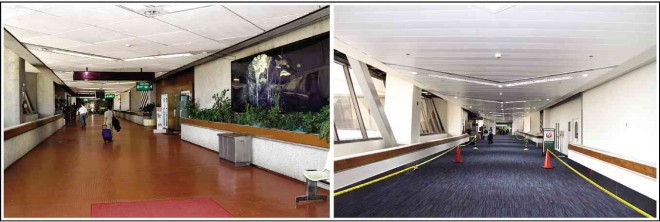
P1.3-BILLION DIFFERENCE The Manila International Airport Authority has released these pictures to show the transformation of Naia Terminal 1 after renovations started in January last year. Upper photo shows the departure concourse while those below are of the departure lobby.
Amid the hammering and whirr of tools, the public address system at Ninoy Aquino International Airport (Naia) Terminal 1 tirelessly issues an appeal: “Please bear with us. We are undergoing renovations to better serve you.”
For Sonia, a frequent flyer since the 1990s, all that work should have been done years ago. Still, the 40-year-old migrant worker is appreciative of the transformation unfolding before her.
“It’s much cooler now, less congested and not as dark as before,” she said. “Now everything looks brighter and more welcoming.”
Not many would have agreed with her four years ago, when the 30-year-old terminal made headlines for supposedly being the worst in the world. The ranking was made by a website that offers a guide for travelers when sleeping at airports—and was seen as a validation of what long-suffering passengers had been complaining about.
The same site also noted how a portion of the terminal’s ceiling collapsed in 2011, raising more serious questions over its structural integrity.
But 14 months after the launch of a P1.3-billion makeover for Naia 1, officials believe that enough has been done to erase its woeful image.
In an interview on Thursday, Manila International Airport Authority general manager Jose Angel Honrado said the rehabilitation work, which started in January last year, is now 85-percent complete and should be finished by May.
Honrado insisted that the massive rehab project was not triggered by the airport being adjudged the worst in 2011. “The structure investigation started in 2010,’’ he said.
As to the online “survey’’ that purportedly served as the basis for Naia’s pitiful ranking, he said: “People keep on referring to it (but) we do not even know who made that survey or how many were surveyed. Nobody knows.”
“We did not react (by renovating) because of that survey. The repairs done in the toilets started even before that report came out,” he said.
Naia 1 manager Dante Basanta said the completed works so far involved structural retrofitting, aesthetic improvements, upgrades in electrical, plumbing, mechanical (weighing and feeding conveyors, etc.) and fire protection systems, and the construction of lounges for hotel bookings and transport services.
The interior was refurbishedwith the installation of new lighting fixtures, flooring and ceiling, and an upgraded air-conditioning system, he said.
Passenger areas or sections generally accessible to the public may be completed by the end of the month, in time for the Holy Week break. “Overall, the present rehabilitation will definitely improve the travel experience of the riding public,” Basanta said.